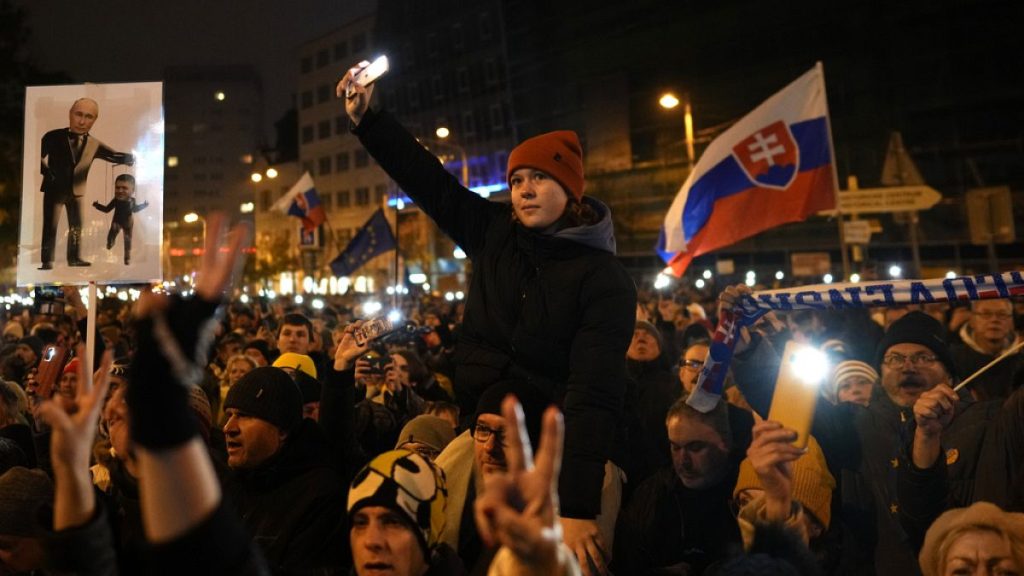The streets of Bratislava, Slovakia’s capital, witnessed a surge of public discontent on Friday as thousands of demonstrators rallied against Prime Minister Robert Fico’s perceived pro-Moscow stance and his recent meeting with Russian President Vladimir Putin. The protest, fueled by a confluence of anxieties surrounding Slovakia’s relationship with Russia and the ongoing Ukrainian refugee crisis, underscored the deep divisions within the country over its geopolitical orientation. Carrying EU and Slovakian flags and brandishing signs proclaiming “We are Europe” and “Treason!”, the protesters voiced their apprehension over Fico’s perceived alignment with the Kremlin, particularly in light of Russia’s invasion of Ukraine.
The demonstration erupted just weeks after Fico’s controversial visit to Moscow on December 22nd, where he met with Putin to discuss gas supplies and other matters. Notably, Moscow framed the meeting as Slovakia’s offer to serve as a neutral venue for peace talks on Ukraine. This visit marked Fico as the third EU leader to hold talks with Putin in the Kremlin since the full-scale invasion of Ukraine in February 2022, following Austrian Chancellor Karl Nehammer and Hungarian Prime Minister Viktor Orbán. This act, coupled with Fico’s subsequent pronouncements, further fueled public unease and spurred the Friday protest.
Adding fuel to the fire was Fico’s threat to cut financial aid to over 130,000 Ukrainian refugees residing in Slovakia. This threat, issued a day before the protest, was presented as retaliation for Ukraine’s decision to halt the transit of Russian gas through its territory to Slovakia. This action, taken by Kyiv on January 1st, resulted from the expiration of a long-standing pre-war transit agreement with Russia’s state energy giant, Gazprom. Ukrainian President Volodymyr Zelenskyy had steadfastly refused to renew the deal, declaring his unwillingness to allow countries to “earn additional billions on our blood.”
The halting of gas transit through Ukraine further complicated Slovakia’s energy landscape. Heavily reliant on Russian gas, Slovakia had attempted to persuade Ukraine to reconsider its decision, arguing that the move would primarily harm Slovakia and the EU through increased prices rather than significantly impacting Moscow. Fico, in a video message posted on Facebook, underscored his government’s willingness to consider retaliatory measures, including cutting electricity supplies to Ukraine, should the gas transit not be resumed or compensation for Slovakia’s perceived financial losses not be provided. This hardline stance further inflamed public sentiment and contributed to the scale of the protests.
The protest in Bratislava resonated with a sense of urgency and apprehension about Slovakia’s future trajectory. Protesters like Lucia Štasselova articulated a fear of falling under Russian political influence, characterizing Fico’s actions as an act of “infinite audacity.” The demonstration concluded with a symbolic display of national unity as participants sang the Slovak national anthem, punctuated by chants of “We are not a Russian rag.” This act of defiance underscored the protesters’ commitment to European integration and their rejection of perceived Russian influence.
The events surrounding the protest highlight the complex geopolitical pressures facing Slovakia, caught between its historical ties with Russia, its reliance on Russian energy, and its commitment to European solidarity. The protest encapsulates a broader struggle within the country over its national identity and its place within the European political landscape. Fico’s actions and pronouncements have exposed deep fissures within Slovak society, sparking a debate about the country’s future direction and its relationship with both Russia and the European Union. The protest serves as a stark reminder of the delicate balance Slovakia must navigate in the face of evolving geopolitical realities and the ongoing conflict in Ukraine.

